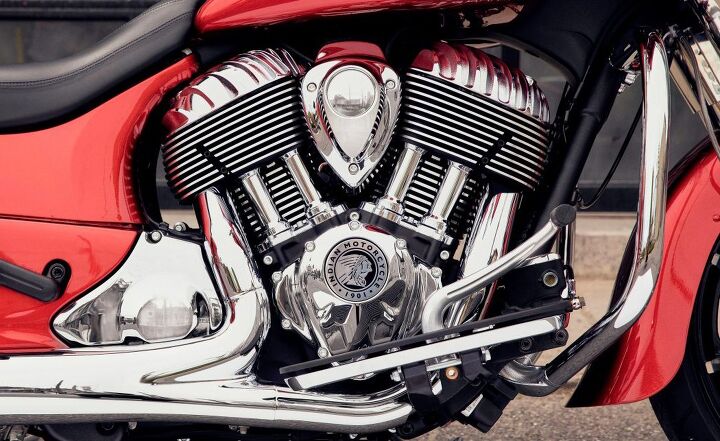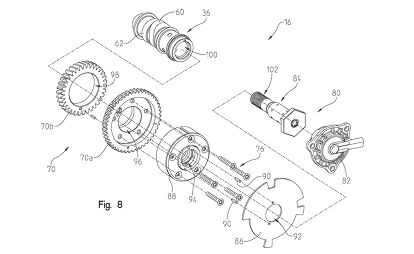Indian is Developing VVT for Thunder Stroke Engine - Motorcycle.com
Indian is Developing VVT for Thunder Stroke Engine
In April, Motorcycle.com broke the news that Indian is about to introduce a new liquid-cooled V-Twin engine originally developed for Victory Motorcycles. The new engine is expected to power a new fixed-fairing tourer and likely several other models, leaving some to wonder about the future of Indian’s air-cooled Thunder Stroke 111 engine.
A new patent application recently published by the U.S. Patent and Trademark Office suggests the Thunder Stroke may not only be sticking around, it may be getting a variable valve timing system. The patent illustrations show an engine that looks nearly identical to the existing TS111 (see below). From the outside, the only visible difference is a circular plate in place of the Indian logo on the cam cover.
Internally, the engine in the patent is also similar, with two valves per cylinder driven by hydraulic roller-rockers. The four pushrods are matched with three camshafts: two single-lobed camshafts for the exhaust valves and a double-lobed center shaft for the two intake valves. That plate that is visible on the outside of the engine is part of the cam phaser assembly used to vary the valve timing.
A cam phaser is used to alter valve timing by rotating the camshaft forward (advancing) or backward (retarding) in relation to the crankshaft’s rotation. Unlike Ducati‘s Desmodromic Valve Timing (DVT) which has cam phasers for both intake and exhaust valves, Indian’s idea applies only to the intake. This makes it more like the system on the Kawasaki Concours 14 which also varies the intake timing, only Indian’s patent is applying it to an overhead valve V-Twin configuration.
The engine control unit controls the cam phaser’s rotation, advancing or retarding the intake cams, affecting the amount of overlap when both intake and exhaust valves are open during the exhaust stroke. According to Indian’s patent application, this allows some of the exhaust gases to flow back into the intake manifold as a form of exhaust gas recirculation. Inert gases from EGR reduces cylinder temperatures, and thus inhibiting the production of nitrogen oxide (NOx) emissions. At lower rpms, however, more valve overlap can result in a rougher idle, so it may be more advantageous to retard the intake timing.
Keeping emissions down will be important in the face of tighter regulations. Euro 5 regulations come into effect on Jan. 1, demanding cleaner engines from motorcycle manufacturers. Reducing emissions is likely one of the reasons Indian’s about to release its new liquid-cooled engine, but adopting VVT technology may also help keep the air-cooled Thunder Stroke compliant with the new restrictions.
If Euro 5 is the main the motivator behind adopting VVT, then we may see Indian introduce it to the Thunder Stroke engine as soon as this year. As always, we’ll have the latest here on Motorcycle.com as more information becomes available.
More by Dennis Chung







































Comments
Join the conversation